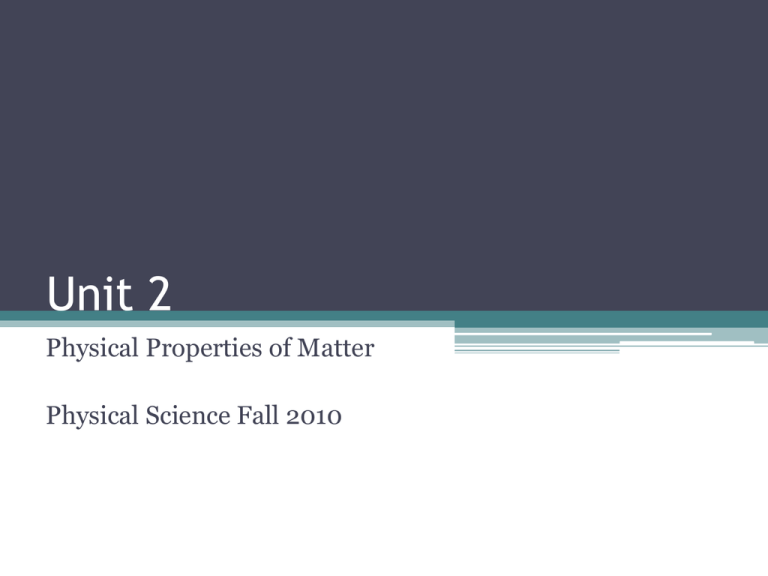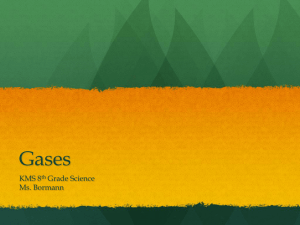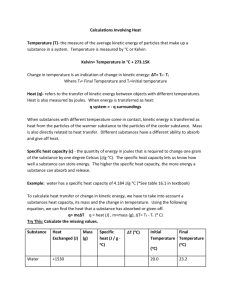Unit 2 Notes
advertisement

Unit 2 Physical Properties of Matter Physical Science Fall 2010 Kinetic Molecular Theory Kinetic = Movement (Energy) Molecule = Particles The more energy in a substance, the faster the particles move. ALL particles in a substance are constantly in motion. Kinetic Molecular Theory Matter • Any substance that has mass and occupies space. • 3 States…or phases Phases of Matter • Solids ▫ The particles are packed tightly together and stay in one position. The particles vibrate slightly between each other… so they’re not completely motionless. Phases of Matter (cont.) • Solids ▫ Solids are the least energetic phase of matter ▫ Solids have a definite volume and a definite shape. Phases of Matter • Liquids ▫ The particles are somewhat packed together and move freely around one another. Phases of Matter • Liquids ▫ Liquids have a medium amount of energy (more than solids, less than gases) ▫ Liquids have a definite volume but not a definite shape. They take on the shape of the container Phases of Matter • Gases ▫ Gas particles spread apart, filling all the space available. Phases of matter • Gases ▫ Gases are the most energetic phase of matter ▫ Gases have no definite volume and no definite shape. Recap Physical Properties All types of matter will have certain characteristics that never change. Some examples are: density, boiling point, freezing point, etc. We call these Physical Properties. Types of Physical Properties Intensive Do not depend on the size or shape of the sample Examples? Color, hardness, BP, etc. Extensive Depend on the sizes of the sample Examples Length, mass, volume, etc. Density • Why things float while other things sink What is Density? • Density is a comparison of how much matter there is in a certain amount of space. • Or how heavy something is for its size • Thing of a rock vs. a cotton ball the same size. vs. http://upload.wikimedia.org/wikipedia/commons/f/f2 /Mossagate.pebble.750pix.jpg http://www.rd.ca/cms/images/image/cottonballs_291_2 0080523-171920.jpg What is Density • Density is Mass divided by Volume D=m/v • D=Density • m=mass(g) • v=volume(mL) • So the unit for Density is: mass (g) volume (mL) Which one is more dense? • Demonstration: People in a square • How about this: Which square is more dense? Which one is more dense? • Now which one is more dense? How to Calculate Density • Density = mass(g) volume(mL) Density M D = V M M = DxV ass D ensity V olume M V = D • Use triangle to figure out which equation to use • If you are given mass and density, you can figure out the volume by covering up the volume triangle So Volume = Mass(g) Density(mL) ? Measuring Density for square objects • Find the mass using a balance • Length x width x height • But what if it’s weird looking? Density of odd-shaped Objects • Find the mass using a balance Graduated cylinder, beaker to find volume • Use ______________________. Lets try some problems An irregular object with a mass of 18 kg displaces 2.5 L of water when placed in a large overflow container. Calculate the density of the object. Givens: Equation: m=18 kg D=m/v v=2.5L D=? kg/L Substitution: ? Kg/L = 18 kg/2.5 L Answer with unit 7.2 kg/L • A brick with a mass of 14 g measures 12 cm x 4 cm x 3 cm. Calculate the density of the object. Givens: Equation: Substitution: Answer with unit A bar of gold with a density of 5 g/ml has a volume of 500 mL. Calculate the mass. Givens: Equation: Substitution: Answer with unit Liquid Layers If you pour together liquids that don’t mix and have different densities, they will form liquid layers. The liquid with the highest density will be on the bottom. The liquid with the lowest density will be on the top. Liquid Layers • Which layer has the highest density? • Which layer has the lowest density? • Imagine that the liquids have the following densities: • * 10g/mL. • * 6g/mL. * 3g/mL. * 5g/mL. • Which number would go with which layer? 3g/mL 5g/mL 6g/mL 10g/mL Gas Laws – Pressure What is Pressure? Pressure What is Pressure? Gas particles push against the sides of what ever container they are in. Pressure is what keeps balloons inflated. Gas Laws - Pressure Factors Affecting Gas Pressure • Amount of gas • Volume • Temperature http://www.bmumford.com/photo/highspeed/Ted1.jpg Gas Laws - Units Pressure can be measured in: Atmospheres (atm) Kilopascals (kPa) Temperature is measured in: Kelvin (K) K = Celsius + 273 We’ll come back to this Gas Laws – Boyle’s Law Robert Boyle was British Royalty that lived in the 17th century. He studied all aspects of science, including alchemy. Do you know what alchemy is? Gas Laws – Boyle’s Law When matter turns into a gas, it behaves differently than other matter. Boyle's Law is used when the pressure of a gas changes. The volume of a fixed amount of gas varies inversely with the pressure of the gas. Boyle’s Law in motion http://www.grc.nasa.gov/WWW/K-12/airplane/Animation/gaslab/Images/chprmt.gif Gas Laws – Boyle’s Law As volume decreases, As volume increases, Pressure increases Pressure decreases. The equation for Boyle’s Law is: V1 x P1 = V2 x P2 Gas Laws – Boyle’s Law A sample of hydrogen gas has a volume of 75.0 mL at a pressure of 0.87 atm. What will the volume of the gas be at a pressure of 1.00 atm if the temperature remains the same? Givens: V1 = 75.0 mL V1 * P1 = V2 * P2 Equation: P1 = 0.87 atm P2 = 1.00 atm 75 mL * .87 atm = V2 * 1.0 atm Substitution: 65.25 mL = V2 Answer with Units: The Kelvin Scale • As T increases, so does kinetic energy • Theoretically, kinetic energy can be zero, but it hasn’t been achieved and probably won’t ever be achieved • Absolute zero- The temperature at which a substance would have zero kinetic energy • The Kelvin Scale- a temperature scale directly related to kinetic energy ▫ Zero on the Kelvin scale corresponds to zero kinetic energy The Kelvin Scale • Units are Kelvins (K), with no degree (o) sign Kelvin relates temperature to kinetic energy! Temperature Conversions • Easy to convert between Celsius and Kelvin ▫ How do you think? oC K? Add 273 K oC? Substract 273 ▫ 25oC K? (25+273)= 298 K ▫ 310 K oC? (310-273) = 37oC • Fahrenheit Celsius? ▫ (oF – 32oF) x 5/9 = oC ▫ (oC x 9/5) + 32oF = oF Gas Laws – Charles’ Law Gas Laws – Charles’ Law Charles’ Law is used when the volume of a fixed amount of gas changes with temperature. Remember the temp must be in Kelvin! Charles’ Law in Motion Gas Laws – Charles’ Law As temperature increases, As temperature decrease, volume increases. volume decreases. The equation for Charles’ Law is: T2 x V1 = V2 x T1 Gas Laws – Charles Law Nitrogen gas in a balloon takes up a space of 1.5 L at 300 K. The balloon is dipped into liquid nitrogen that is at a temperature of 75 K. What will be the volume of the helium in the balloon at the lower temperature? Givens: V1 = 1.5 L V1 * T2 = V2 * T1 Equation: T1 = 300 K T2 = 75 K 1.5 L * 75 K = V2 * 300 K Substitution: .375 L = V2 Answer with Units: Gas Laws – Charles’ Law Gas Laws – The Real World Gas Laws – The Real World





